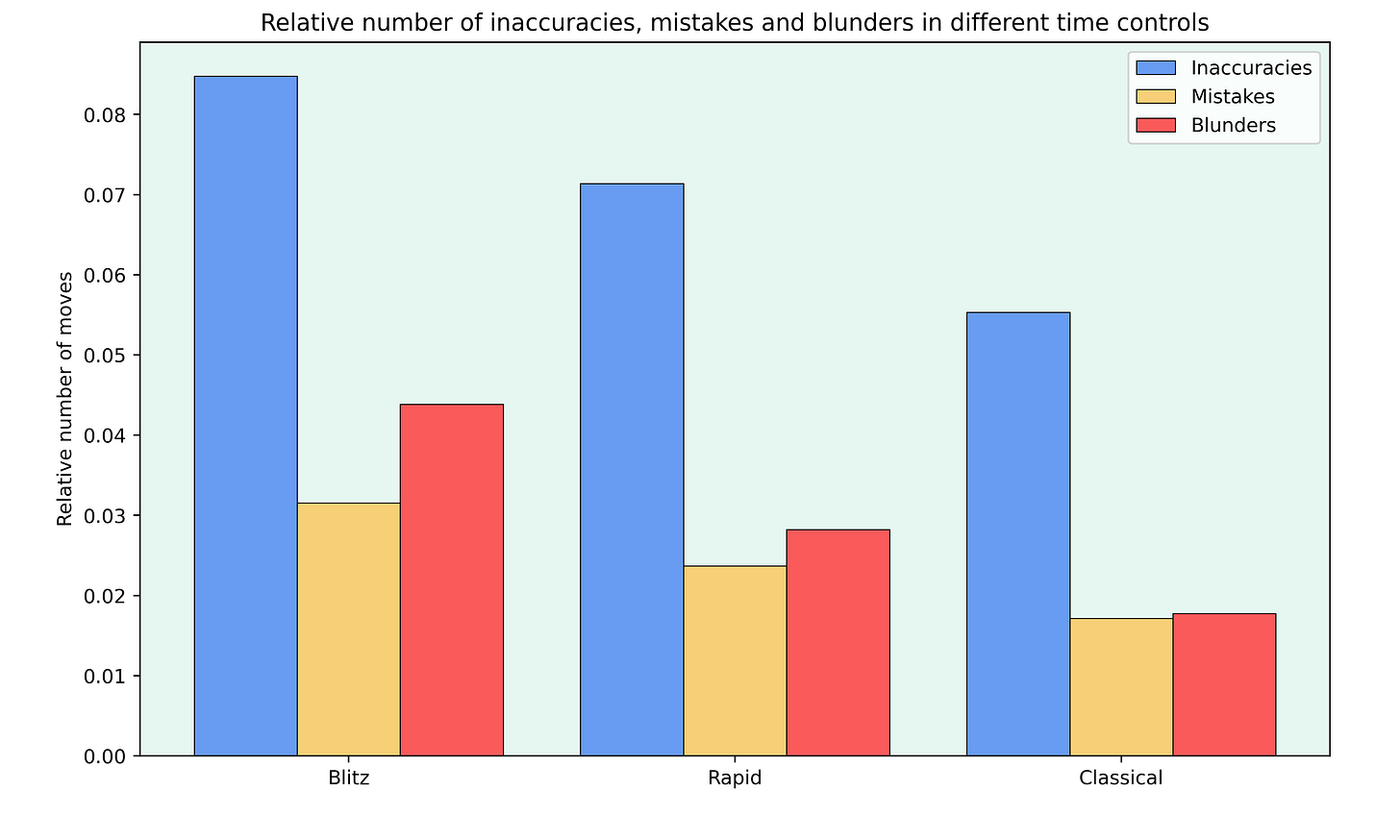Looking at the Quality of Rapid and Blitz Games
How does the quality of play from GMs change in different time controls?
In a previous post, I took a look at the accuracy of grandmasters in classical games. Now I also want to take a closer look at the quality of play in OTB rapid and blitz games.
For the games, I only looked at OTB games from grandmasters. This was done because Lichess analyses these high level games, and it allowed me to directly download the PGN files with engine analysis, instead of analysing games for weeks.
As for the time controls, I only picked 15+10 rapid and 3+2 blitz games, mainly because these are the time controls for the world rapid and blitz championships, so there are many high level games at these time controls.
Comparison to classical
To get a first feel for the difference in quality of the games, I compared the rapid and blitz games to classical games.
Firstly, I looked at the inaccuracies, mistakes, and blunders in each time control, which I defined to be moves that reduce the expected score by 5, 10, and 15 percent, respectively.
As one expects, the relative number of suboptimal moves reduces as players have more thinking time. It’s interesting to see that the relative number of blunders decreases more quickly than the relative number of mistakes. It makes sense that these big oversights occur more often in shorter time controls, but it’s nice to see it backed up by the data.
I also compared the quality of whole games for the different time controls. To do this, I calculated the average expected score loss per move in each game and then plotted the percentage of games below any average expected score.
So, for example, in the graph below, one can see that the average expected score loss per move is at most 1.75% for the most accurate 50% of classical games, while it is 2.91% for the most accurate 50% of blitz games.
The line for classical games has the steepest slope, which means that the relative number of games below a certain expected score loss is higher compared to the quicker time controls, as expected.
One interesting detail is that the gap between rapid and classical games is smaller than the gap between rapid and blitz games. This means that moving from rapid to blitz games decreases the accuracy more than going from classical to rapid. This surprised me, as the time difference between rapid and blitz is much smaller than the difference in clock times between rapid and classical.
Comparing different ratings
Finally, I want to look at the quality of play for different rating ranges above 2500. I decided to look at two rating bands, namely games between players rated between 2500 and 2700, and games between players rated 2700+.
In the classical games, there wasn’t a big difference between the two rating groups, so I’ll only focus on the rapid and blitz games.
Note that I took the FIDE rapid and blitz ratings for this, so a 2700+ blitz player may not be 2700+ in classical (or in rapid) and vice versa. There are also fewer games in each group than before, so the lines don’t look as smooth.
It’s interesting to see that there isn’t any difference in the quality of the most accurate 30% of rapid games of both rating bands. I’d guess that these are the games where the players reach an equal position early on and the game ends in a draw without any big adventures. In general, there isn’t a big gap in the quality of rapid games played between GMs of different ratings.
However, the difference is very noticeable in blitz chess. The quality of the games by 2700+ blitz players is much closer to the quality of rapid games between 2500-2700 players than to blitz players in the same rating range. I didn’t expect the difference to be this big between the two time controls.
Further questions
There are many things that one could explore related to what I did here. I didn’t do these things, as it’s difficult to get enough analysed games. But here are some additional ideas that I may cover in the future.
One interesting topic would be to look at smaller gaps in the time control, like comparing 15+10 games to 25+10 games. The big problem with this is that apart from the Grand Chess Tour, there aren’t many 25+10 rapid events.
Another fun thing to look at would be the difference in quality of play between OTB and online blitz games. A comparison would be a bit difficult, as people are usually less concentrated when playing online, and one would have to handpick specific players to use for the comparison.
Finally, it would also be very interesting to see at which classical rating super GMs are playing in blitz, by comparing the accuracy of the games. For this, one would need to analyse a lot of classical games below the grandmaster level, which are more difficult to find. Thanks to Lichess broadcasts, there are many smaller events where one can download the PGNs, but these games are understandably not analysed by Lichess, as this would take a lot of CPU time.
Let me know if there is any similar topic to the one I covered here that you’d like to see in the future.







I would love to dig into the maximum expected score loss per move--what if we removed the situations where the player is +15 and then 'blundered' and ended up at +9 and still won? Like is there a way to filter out the moves where the score loss is practically meaningless?